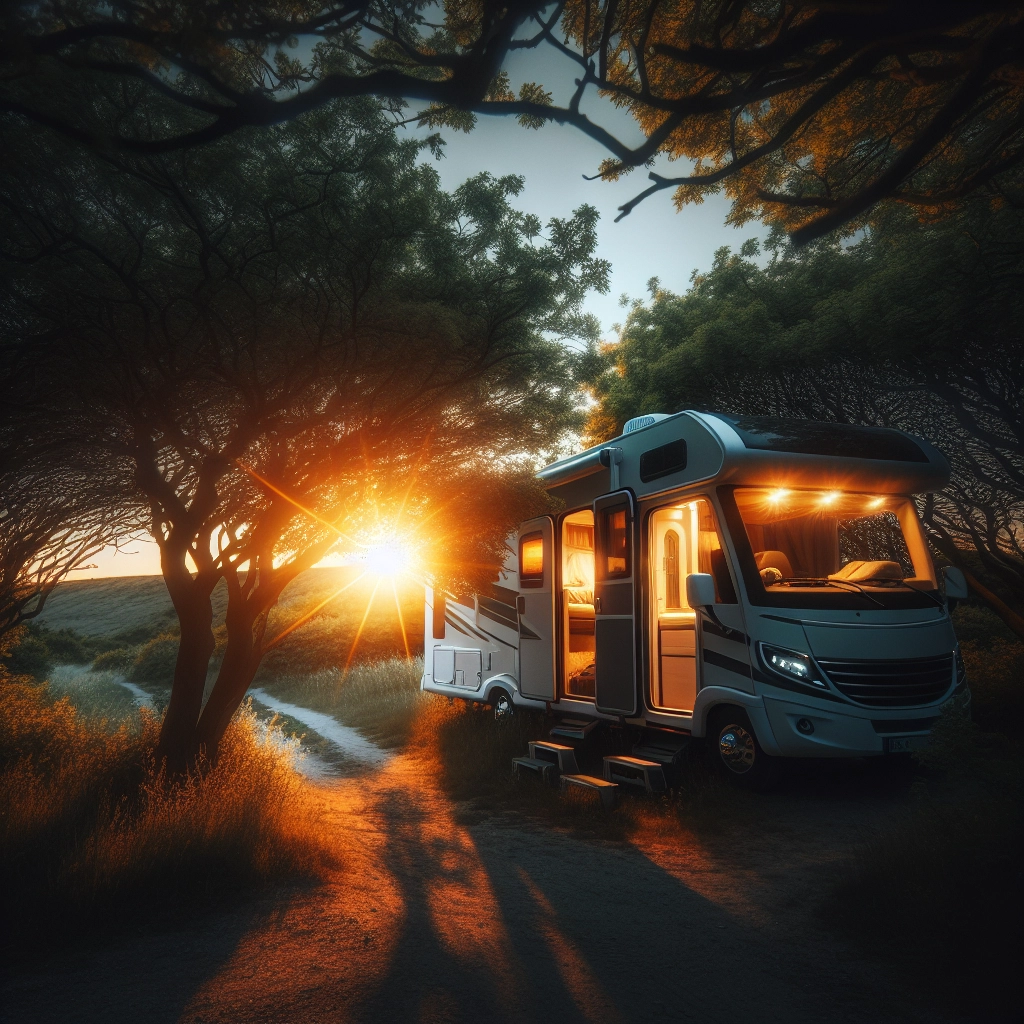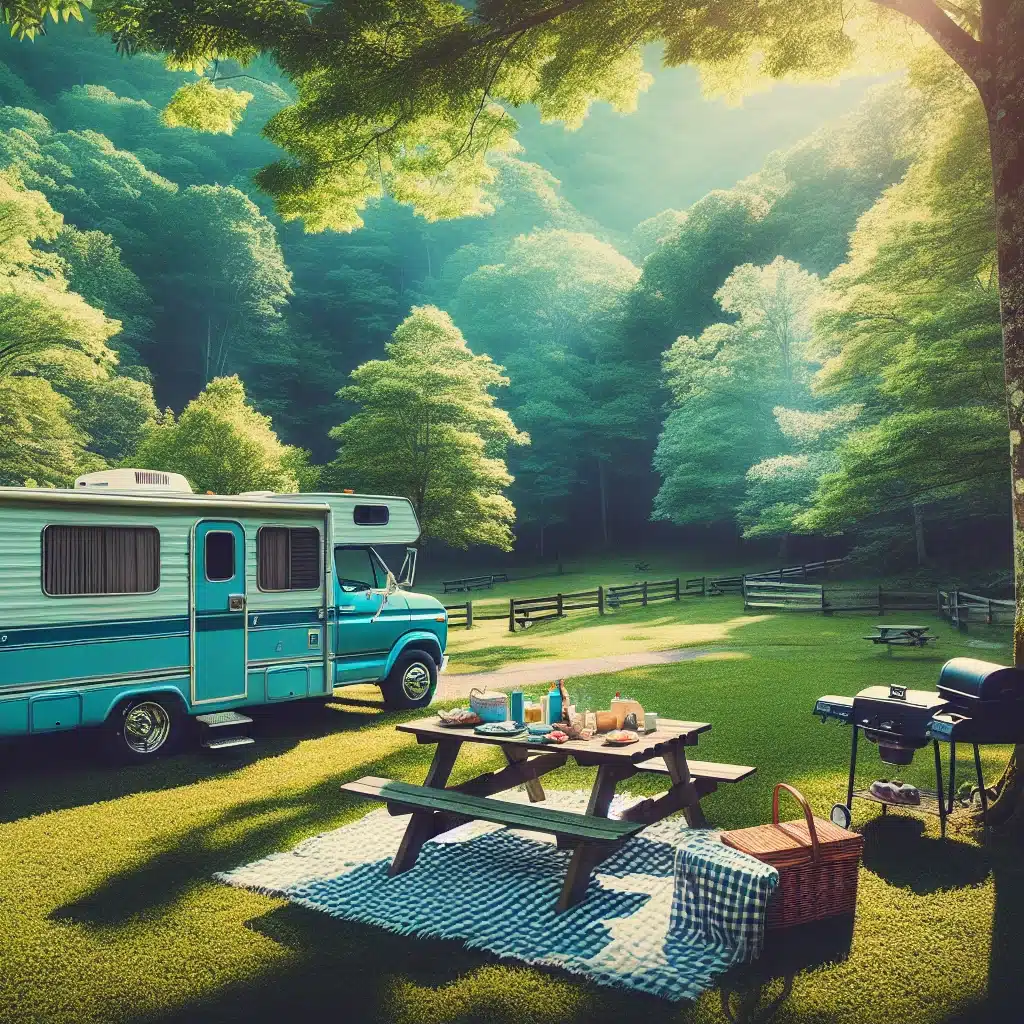Table of Contents

Key Takeaways: Harnessing the Sun for Off-Grid Adventure
- Portable solar kits provide a renewable power source for RVs, enabling off-grid camping or “boondocking”.
- Going solar reduces reliance on noisy generators and costly hookups, offering freedom and cost savings.
- Solar power is an eco-friendly alternative, reducing the carbon footprint of your RV adventures.
- Efficient and easy to set up, portable solar kits can be tailored to meet the specific energy needs of your RV.
- With solar power, you can explore more remote locations without worrying about access to traditional power sources.
Quick Rundown: Solar Power Transforming RV Boondocking
Imagine the freedom of camping in pristine, remote locations without giving up the comforts of home. That’s the beauty of boondocking with a portable solar kit. It’s like having your own power plant right on the roof of your RV. You can keep your fridge running, charge your devices, and even watch TV, all without a power hookup in sight. This self-sufficiency is transforming the way RVers experience the great outdoors.
Why Go Solar? Unplugging from the Grid
There’s something liberating about not being tethered to a campground’s electrical grid. Solar power allows you to break free from the constraints of designated camping spots and costly fees. It’s not just about saving money, though that’s a significant perk. It’s about the tranquility of nature, the hush of the wind through the trees, and the stars unspoiled by artificial light. Solar power makes this serene escape possible.
The Essentials of Boondocking with RVs
Boondocking, or dry camping, is all about self-sufficiency. You’re not just parking your RV; you’re setting up a temporary home where there are no water, power, or sewer hookups. To do this successfully, you need to be prepared. This means having enough water, managing your waste, and most importantly, ensuring you have a reliable power source. That’s where portable solar kits shine.
Understanding the Role of Portable Solar Kits
Portable solar kits are the heart of your power system when you’re away from the grid. They convert sunlight into electricity, which charges your RV’s batteries. These kits come in various sizes and configurations, allowing you to customize your setup based on how much power you use. Plus, they’re designed for the nomadic lifestyle – they’re durable, easy to install, and can be set up or packed away in minutes.

Powering Up: The Efficiency of Portable Solar Kits
Efficiency is key when it comes to solar power. Modern portable solar kits are engineered to capture as much sunlight as possible, converting it into usable electricity with minimal loss. This means even on days when the sun plays hide and seek, you can still gather enough energy to keep the essentials running smoothly.
Generating Your Own Electricity on the Go
With a portable solar kit, you’re the master of your own energy. You decide where to set up camp, and your solar kit takes care of the rest, soaking up the sun’s rays and storing energy for when you need it. This independence is not just empowering; it’s practical. You can stay charged up in the middle of the desert, forest, or by a secluded lakeside – your adventure doesn’t have to stop when the power cord doesn’t reach.
Key Differences Between Portable and Fixed Solar Systems
When considering solar for your RV, you might wonder about the difference between portable and fixed systems. Portable solar kits are all about flexibility. They can be moved to catch the sun’s rays during different times of the day and can be packed away when you’re on the move. Fixed systems, on the other hand, are mounted permanently on your RV’s roof. They’re always exposed to sunlight but don’t offer the same angle adjustments as portable panels. Each has its benefits, but portable kits win for boondockers who crave the ability to chase the sun.
The Financial Upside: Saving Money with the Sun
Switching to solar isn’t just good for the earth; it’s great for your wallet too. After the initial investment in a solar kit, the sun’s energy comes absolutely free, which means you can say goodbye to the ongoing costs of generator fuel or campground power fees. Over time, the savings add up, making solar power a smart financial move for frequent RVers.
Reducing Recurring Costs
Think about all the expenses tied to traditional RV power sources: fuel for generators, maintenance costs, and the ever-increasing fees for RV park hookups. With a solar kit, these costs plummet. The sun doesn’t send a bill, and solar panels require very little upkeep. This means more money stays in your pocket, where it belongs.
Calculating Long-Term Savings
It’s not just about the immediate savings; it’s the long-term financial benefits that really shine. A quality solar kit can last for years, potentially saving you thousands in power costs. To figure out your long-term savings, consider the average cost of your usual power sources and compare it to the one-time purchase of your solar setup. Over time, you’ll see how solar pays for itself and then some.

Eco-Friendly Energy: The Green Benefits of Solar Power
Solar power isn’t just about independence and savings; it’s a step towards a cleaner planet. By harnessing the sun’s energy, you’re reducing the demand for fossil fuels, which are the main culprits behind air pollution and climate change. Every kilowatt-hour of solar energy used is a win for the environment.
Minimizing Environmental Footprint
As an RVer, you’re drawn to the beauty of the natural world. Using solar power aligns with the desire to preserve that beauty. It produces no emissions, no noise, and no pollution. This means you can enjoy the sounds of nature instead of the rumble of a generator, all while knowing you’re doing your part to keep the environment clean.
Sustainable Living and Boondocking
Boondocking is the ultimate expression of sustainable travel. By using solar power, you’re not just avoiding the grid, you’re actively reducing your reliance on non-renewable resources. This sustainable approach to living on the road means you can enjoy the wilderness without leaving a mark, ensuring it remains untouched for future generations to explore.
Freedom to Roam: Solar Kits Enhancing Travel Flexibility
One of the biggest perks of having a portable solar kit is the sheer flexibility it offers. Your travel plans are no longer dictated by the next available RV park with power hookups. With the sun as your fuel station, you can explore far and wide, setting up camp wherever you please, from the sun-drenched beaches to the secluded mountain valleys.
Camping Without Limits
Picture this: You’ve found the perfect spot by a peaceful river, miles away from the nearest power outlet. With a portable solar kit, this secluded paradise doesn’t have to remain a daydream. You can stay for days or weeks at a time, basking in the tranquility of your own private campsite, your solar kit silently soaking up the sun’s rays to power your home on wheels.
Versatile Setup for Diverse Environments
No matter where your travels take you, a portable solar kit is ready to adapt. Whether you’re parked in the desert’s open expanse or nestled in a forest clearing, you can position your panels to capture the maximum amount of sunlight. This versatility is key to maintaining a steady power supply, ensuring your RV is always charged and ready for the next adventure.
Setting Up Your Solar Kit: Tips and Tricks
Getting your solar kit up and running is easier than you might think. With a few simple steps, you can be on your way to energy independence. The key is to start with the right kit for your needs and follow some best practices for installation and maintenance.
Choosing the Right Kit for Your Needs
Before you dive into the world of solar, take a moment to assess your energy needs. How much power do you typically use in a day? What appliances are must-haves on your trips? Answering these questions will help you select a solar kit that matches your lifestyle, ensuring you have enough juice to keep all your gadgets going without over-investing in unnecessary capacity.
Installation and Maintenance Best Practices
Installation is a breeze when you follow the manufacturer’s instructions. Securely mount your panels, connect the wires without crossing them, and you’re almost done. Maintenance is just as straightforward. Keep the panels clean, check the connections occasionally, and monitor your batteries to ensure they’re charging properly. A little attention goes a long way in keeping your solar system at peak performance.
Making the Most of Your Portable Solar Power
Once your solar kit is in place, it’s all about optimizing your setup to get the most out of every ray of sunshine. Position your panels so they face the sun directly, and move them throughout the day if needed. Use energy-intensive appliances during peak sunlight hours, and consider energy-saving habits to stretch your stored power further. With these strategies, you can maximize your solar kit’s potential and enjoy uninterrupted power, no matter where you park.
Maximizing Efficiency and Power Generation
To squeeze every drop of power out of your solar panels, you need to consider their placement carefully. Aim to park your RV so that the panels get direct sunlight throughout the day. If your panels are adjustable, tilt them towards the sun as it moves across the sky. It’s also smart to avoid parking under trees or in shadows, which can significantly reduce your panels’ efficiency. Remember, even a small amount of shade can have a big impact on solar power generation.
Adapting to Varying Weather Conditions
Weather can be unpredictable, but your solar power doesn’t have to be. On cloudy days, your panels will still generate electricity, just at a lower rate. You can compensate by conserving energy—think about turning off non-essential appliances and saving battery power. Also, consider adding a battery monitor to your setup to keep a close eye on power usage and storage. This way, you can adapt your energy habits to the weather, ensuring you always have enough power.
Real World Usage: Stories from the Road
There’s no better way to understand the impact of solar power on boondocking than hearing stories from those who’ve lived it. Take Sarah and John, for example, who spent a month touring the Southwest in their solar-powered RV. They shared how solar allowed them to discover hidden gems far from the nearest RV park, turning their trip into an adventure of a lifetime. Their story is just one of many that showcase the freedom and joy that solar power brings to the RV lifestyle.
Tips from Experienced Boondockers
- Always park in the sunniest spot available to maximize solar charging.
- Invest in a high-quality battery bank to store the solar energy you collect.
- Keep an eye on your energy consumption, especially on cloudy days or during extended stays.
- Regularly clean your solar panels to ensure they’re operating at full efficiency.
- Consider a backup power source, like a generator, for those just-in-case scenarios.
- Stay informed about the weather forecast to plan your energy usage accordingly.
- Use LED lighting and energy-efficient appliances to reduce your overall power needs.
Recommended Gear and Gadgets for Solar-Powered RVing
When you’re harnessing the power of the sun, having the right gear can make all the difference. A solar charge controller is essential for protecting your batteries from overcharging. A pure sine wave inverter will ensure you can safely power sensitive electronics. And don’t forget about a good set of deep-cycle batteries to store the energy you collect. These are just a few of the gadgets that can help you make the most of your solar-powered RV experience.
FAQs
Got questions? You’re not alone. Many RV owners are curious about how to integrate solar power into their travels. Here are some of the most common questions and straightforward answers to help you get started.
How Do I Determine the Size of the Solar Kit Needed for My RV?
To find the right size solar kit for your RV, start by calculating your daily power usage. Look at the wattage of each appliance you use and how long you run them each day. Then, consider how many hours of sunlight you can expect to harness. A simple formula is to divide your daily watt-hour usage by the number of sunlight hours, giving you the wattage your panels need to produce. Always round up and consider adding a bit extra for those less-than-sunny days.
Can I Run My Air Conditioner on Solar Power While Boondocking?
Running an air conditioner on solar power is a common question, and the answer is yes, but with some caveats. Air conditioners consume a lot of power, so you’ll need a substantial solar array and battery bank to handle the load. It’s all about the capacity of your system. If you have enough solar panels and battery storage to cover the energy consumption of your air conditioner, then you can enjoy cool air even in the middle of nowhere.
How Can I Optimize My Solar Panels’ Performance During Shaded Conditions?
Shade is the nemesis of solar power generation, but there are ways to mitigate its effects. First, consider using solar panels that are designed to perform better in low-light conditions. Additionally, positioning your panels at different angles can help capture more sunlight as the sun moves across the sky. Using a maximum power point tracking (MPPT) charge controller can also help optimize the energy conversion, even when the panels aren’t in full sun.
Is It Possible to Combine Portable Solar Kits with Other Power Sources?
Absolutely! Combining your portable solar kit with other power sources, like a generator or shore power, can provide you with a versatile and robust energy system. This hybrid approach allows you to use solar power when it’s available and switch to an alternative when it’s not. It’s the best of both worlds, giving you the freedom to camp anywhere while ensuring you always have the power you need.
What Maintenance Do Portable Solar Kits Require?
Maintenance for portable solar kits is surprisingly minimal. The most important task is to keep the panels clean, as dirt and debris can block sunlight and reduce efficiency. Simply wiping them down with a damp cloth can do the trick. It’s also wise to check the connections and cables periodically to ensure everything is tight and corrosion-free. Other than that, just keep an eye on your battery levels and the overall performance of your system.
Embracing solar power for your RV is not just a smart choice; it’s a commitment to a more adventurous and eco-friendly way of life. So, go ahead and soak up the sun, power your travels, and enjoy the boundless beauty of the great outdoors, all while leaving a lighter footprint on the earth. Happy boondocking!
- Boondocking RVs: Flexible Solar Solutions – 3 March 2024
- Renewable Energy Tips for Full-Time Boondocking RVers – 2 March 2024
- Boondocking Solar Power Systems: Sizing Options & Solutions for Motorhomes – 1 March 2024
